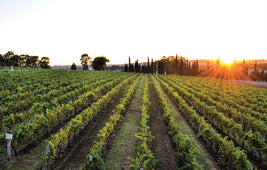How is Sparkling Wine Produced?

The science behind each sparkling wine production method involves distinct processes that contribute to the development of bubbles, flavors, and aromas.
Although traditionally Chardonnay and Pinot Noir are the most common sparkling wine varieties, it's important to note that many New World winemakers have more flexibility in their grape choices. Popular varieties such as Sauvignon Blanc and Chenin Blanc are often used, and blending different varieties to achieve the desired flavor profile and balance is also very common.
Factors such as yeast strain, fermentation temperature, grape composition, and aging conditions all influence the final wine. The meticulous control of these variables by winemakers determines the style, flavor profile, and quality of the sparkling wine produced.
Traditional Method (Méthode Traditionnelle)
The Lowestoft, Thalia and Yilgarn sparkling wines are produced using this method.
The Traditional Method, synonymous with the prestige of Champagne, is a meticulous process that begins with the creation of a base wine, usually produced from Chardonnay and/or Pinot Noir. Chardonnay contributes elegance and acidity, while Pinot Noir adds body and richness.
Following primary fermentation, a mixture of yeast and sugar, known as liqueur de tirage, is added to induce a second fermentation within the bottle. The wine then undergoes a period of aging on lees (dead yeast cells and other sediment), contributing complexity and texture to the final wine. Autolysis, the breakdown of dead yeast cells, also imparts creamy and toasty notes.
Once maturation is complete, the sediment is removed through a process called disgorgement, and a dosage (sugar, or a mixture of wine and sugar) is added to achieve the desired sweetness level.
Fun Fact:
Did you know that a standard Champagne bottle contains approximately 49 million bubbles?
Charmat Method
The Strelley Farm Estate sparkling wines are produced using this method.
Also known as the Tank Method, the Charmat Method offers a more straightforward, efficient approach.
After primary fermentation, the base wine is transferred to a pressurised tank and a mixture of sugar and yeast is added to induce secondary fermentation. This method preserves fresh fruit and floral characters, without the extended lees aging typical of the Traditional Method. Once fermentation is complete, the sealed tank traps carbon dioxide, creating bubbles in the wine.
Fun Fact:
This method is responsible for the fruity and floral notes found in many Proseccos.
Carbonation Method
The Carbonation Method is the most straightforward production technique, introducing carbon dioxide directly into still wine to create bubbles. While this method is more cost-effective and yields a simpler profile, it lacks the depth and complexity associated with prolonged lees aging in the bottle, making it a popular choice for more easy-drinking sparkling wine styles.
Fun Fact:
The Carbonation Method is the same process used to carbonate your favorite fizzy drinks.
Transfer Method
The Transfer Method combines elements of both the Traditional and Charmat methods.
Similar to the Traditional Method, secondary fermentation occurs in the bottle, contributing to the wine's complexity. However, after this stage, the wine is transferred to a separate tank to eliminate sediment, streamlining the production process and avoiding the labor-intensive disgorgement of individual bottles.
Shop our range of award-winning sparkling wines here.


























